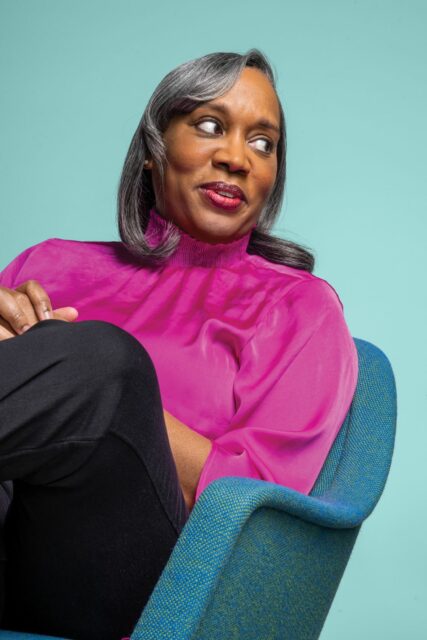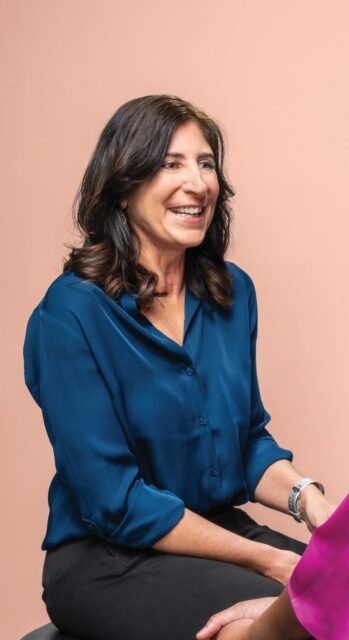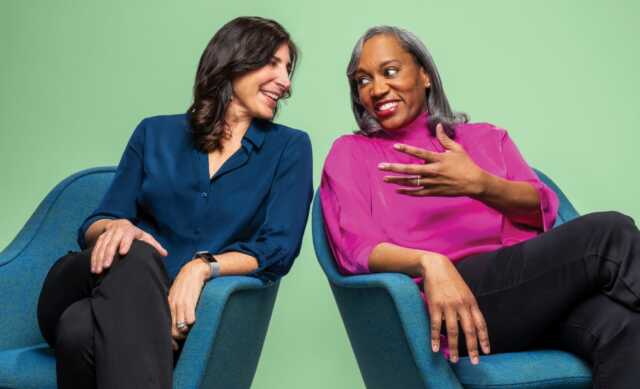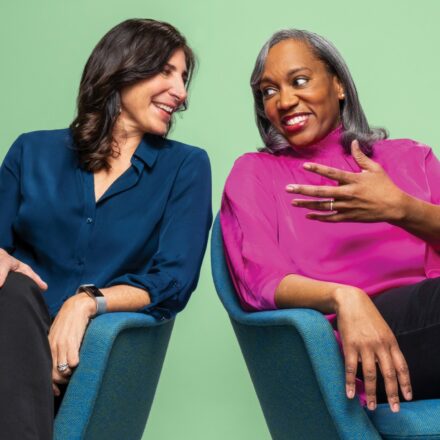By Christina Westbrook, editor in chief, Realize | Photography by Jeff Wilson
Last year, 38 million U.S. workers decided it was time to leave their jobs. The reasons given are myriad and industry opinions are diverse.
Jenn Saavedra, chief human resources officer at Dell Technologies, and Vanice Hayes, chief diversity officer at Dell Technologies, discuss how to capitalize on your company’s strengths to attract new hires while building an authentic culture that will retain—and even grow—the talent you already have.
The wave of people quitting their jobs in 2021 has been coined the Great Resignation. The tech industry, in particular, was hit hard. Why do you think this is happening?
Jennifer Saavedra: I’ve heard that term a lot, but it suggests to me that people are just leaving the workforce completely. While that might be true for some, I don’t think it accurately reflects what we’re witnessing. I prefer other names it’s been given: the Great Reflection or Great Reshuffling. In the last 24 months, people have reconsidered what they value and what they want from work and life.

Vanice Hayes: Yes, I completely agree. I think the expansion of choice has proven you can make money in different ways. In the past, you would go to work at a company for 20 or 30 years, and then you would retire. Now people want more agency over the flow of their day and the path of their careers. We want to help our team members and potential hires find that here at Dell.
JS: This is where empathy, purpose and culture come into sharp focus. We always make decisions that align with our culture and prioritize the health and safety of our team members. In the tech industry, where things change so rapidly, staying rooted in your why keeps you from spinning.
VH: And I think tech companies that didn’t have a flexible work environment before 2020 and then tried to be more flexible than they felt comfortable with may have created roadblocks. Perhaps companies couldn’t provide the real flexibility and choice employees required? Or they tried a hybrid approach, and it didn’t work—saying they’re flexible, but the reality is that employees must come back in on certain days and times?
I don’t know for a fact if this is the reason this is happening in tech, but it’s surely a possibility. At Dell, it’s part of our culture to always lead with the well-being of our people—this kept our flexibility initiatives on target with our team members’ needs.
Dell is not experiencing the same job attrition as most companies. Why do you think this is?
JS: Our team members want to do something that is more than just work itself; they want to contribute and make the world a better place. They want to know that they’re developing and have opportunities to keep growing. Nobody wants to be static. Last year, 30,000 Dell team members moved to new roles inside our company, expanding their experience and potential. We invest in this internal movement because, as MIT reports, even lateral opportunities are 12 times more predictive of employee retention.
While some companies or industries can’t wait for things to “go back to the way things were,” that’s never a strategy for success. A strategy is never, “Let’s go back.” It’s always, “Let’s go forward.” Let’s define the future together. And I think that’s something that has helped us tremendously.
VH: Team members want to be surrounded by amazing people and a culture they believe in. I think every company is different, and every individual is different. We do the hard work to make sure our team members feel appreciated for being themselves.
What sets Dell apart from other companies in the industry that are vying for the same talent?
VH: We’re a purpose-driven, founder-led company. We are here to create technologies that drive human progress. Michael Dell says time and time again, “Our most durable, competitive advantage is our culture and our people.” He believes this, and it permeates everything we do. We all feel it. And that is the key—people know when it’s inauthentic. All decisions you make as a company should align with your true culture.
JS: We even ask our team members what they think—through our annual Tell Dell survey—to ensure that our Culture Code and our People Philosophy aren’t just words on paper. And 98% of our team members tell us they feel like we are living by our Culture Code every day.
The survey is a great vehicle for all team members to express their voices, not just to their direct leader, but all the way up to myself and the executive leadership team. It’s how we know if we’re doing well and where we can do better. We ask a lot of questions: “Are we creating the environment where you can be your authentic self, be your best and do your best work?” “Is this an inclusive environment?” And then we give our leaders that information so they can continue to create the best environment for their teams.
If you only focus on hiring for diversity, but you do not have a culture that is inclusive and embraces diversity, those employees will leave.
—Vanice Hayes, chief diversity officer, Dell Technologies
VH: Remember, if your team members don’t feel like they’re part of something, then they’re going to leave. I think a lot of companies decide to be diverse and start by poaching underrepresented talent and offering them huge salaries—but once that new talent is incorporated into the company, what if the culture piece is missing? If you only focus on hiring for diversity, but you do not have a culture that is inclusive and embraces diversity, those employees will leave.
Digging deeper on that, how do diversity and inclusion inform Dell’s culture?
VH: We want the most innovative team and culture, bringing forward different perspectives and ensuring a culture where everyone can do their best work, all while preparing the next generation with the skills for a digital future. We want to embed inclusion in everything that we do. It shouldn’t be a check-the-box activity.
At Dell, we want enthusiastic people on our team, no matter who you are, what you look like, what your background is. We want to hear from you. We want you to bring your voice, your strengths. We always ask people to speak up and contribute. That’s just how we operate and how we work. We’re also trying to drive education and awareness on all things related to inclusion—not just bias—but also understanding the things that make us different are what make us wonderful as a company.

JS: Living by our Culture Code is how we inspire our people and culture, and it also means making the tough calls. If there are people not representing our culture, not treating people with respect or embracing our shared values, then we coach and support them to help them understand why our culture matters to how we work and lead. People are watching to see if we mean what we say, and I’m proud of us as a company. We walk our talk and make those tough calls when we need to so that we ensure our culture is more than words on paper. This goes for everyone. No one is exempt.
VH: Yes! There’s no special pass for senior leaders. This trust is so important. Our customers trust us, our team members trust us, our communities trust us because we always try to do the right thing. That’s something that comes from the top and permeates throughout our company.
We have a program here at Dell called Be the Change, which focuses on topics related to inclusion. All team members participate, starting at the top with our senior leaders. Michael went through the training; as did his leaders and their leaders, and all team members. Everyone participates. This is another step in our journey towards awareness.
We didn’t just start educating our people on diversity and inclusion two years ago when George Floyd was murdered. This is something we’ve been doing for years and is where culture and authenticity matter.
How is leadership training fundamental to establishing the company culture?
JS: We build empathetic leadership here at Dell. We teach our leaders not to assume they know what their team members need. As we’ve been shifting and adjusting during the past two years, we encourage our leaders to think of it as re-onboarding: Openly talk with your team members about what they need or want out of flexibility.
The goal is for our leaders and their teams to feel supported. We have a high-performance culture, so we want our leaders to know that we’ll still get the job done, but it’s okay to get it done in a different way. It’s priceless for team members to have that level of empathy from their leaders.
VH: We also provide training to make our leadership goals actionable. In 2020, we put all leaders—and I mean all of them—through empathy training while we learned to work in this hyper-remote world.
We’ve learned that social connection is the greatest predictor of long-term happiness. We have worked with our leaders to uncover new ways to connect, getting past the idea that connection is forged at the water cooler. Leadership that enables team members to thrive means more people are happy and want to stay at Dell.
What can companies do to thrive in this hiring market?
JS: Never forget that your secret weapon is retention. We provide opportunities for lateral and upward mobility. We’ve built certification programs, employee resource groups, sales universities, and learning and development programs. We are equally as invested in growing and retaining our internal team members as we are in attracting additional qualified talent.
But we do expect a global tech shortage of 4.3 million by 2030. This shortage will require us to simultaneously widen our recruitment nets and dig deeper into our current talent pool to continue to have the best talent in technology.
VH: Absolutely. We look for talent in a wide variety of places like community colleges and historically Black colleges and universities. We also partner with professional groups such as the National Society of Black Engineers. We are absolutely widening the net. And I know Dell will be better for it.
How do you create a culture where team members want to stay?
JS: Know your authentic purpose and culture, and then create a people philosophy from there. And remember that culture isn’t done, it’s lived. Building your authentic purpose and culture starts with data: “Who are we?” “How do others see us?” “Do our initiatives align with our values?” These are questions you should ask yourself all the time.
And when it comes to this hiring market we’re in, ask your people: “Why are you leaving?” “Why are you staying?” “What do you value that you aren’t getting?” “What do you need?” This data—coupled with your purpose, culture and people—allows you to align your company with what matters most to your employees and leaders.
Know your authentic purpose and culture, and then create a people philosophy from there. And remember that culture isn’t done, it’s lived.
—Jenn Saavedra, chief human resources officer, Dell Technologies
VH: Your commitment to supporting a culture that enables every person to feel they can be their authentic selves requires commitment from all levels within your company. This kind of commitment will keep your “say/do ratio” high and will gain the respect of your teams.
What learning has been top of mind when it comes to company culture?
JS: That there isn’t a playbook for what we’ve been through or what we’re going through. There is no one right answer. I worry when I see other companies cherry-picking what they think are best practices. If it isn’t true to who you are, it will feel inauthentic and people will see right through it, and it won’t work. Define who you are, what you value and what culture you want to create, and then permeate that through your policies, practices and behavior. Do what you say and make sure it all aligns with who you truly are.
VH: Exactly, and I really believe it all starts with leadership. Everything we care about, our whole culture, starts with Michael. People look up and he’s consistent all the time. So, again, you have to be true to the culture of your company. People have to feel and believe that where they work is fantastic. Their team, their day-to-day interaction with their leaders and peers, all those things need to be congruent.
It’s important to not just tell people to be a certain way, but to actually be that way. And I feel fortunate we have that at Dell.
Want to read more stories like this? Check out Realize magazine.

